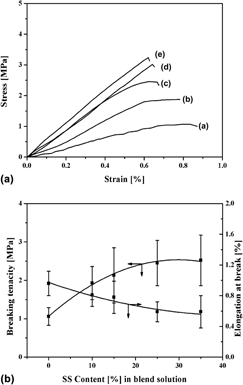Crossref Citations
This article has been cited by the following publications. This list is generated based on data provided by
Crossref.
Hang, Yichun
Zhang, Yaopeng
Jin, Yuan
Shao, Huili
and
Hu, Xuechao
2012.
Preparation of regenerated silk fibroin/silk sericin fibers by coaxial electrospinning.
International Journal of Biological Macromolecules,
Vol. 51,
Issue. 5,
p.
980.
Pan, Hui
Zhang, Yaopeng
Hang, Yichun
Shao, Huili
Hu, Xuechao
Xu, Yuemin
and
Feng, Chao
2012.
Significantly Reinforced Composite Fibers Electrospun from Silk Fibroin/Carbon Nanotube Aqueous Solutions.
Biomacromolecules,
Vol. 13,
Issue. 9,
p.
2859.
Sun, Mengjie
Zhang, Yaopeng
Zhao, Yingmei
Shao, Huili
and
Hu, Xuechao
2012.
The structure–property relationships of artificial silk fabricated by dry-spinning process.
Journal of Materials Chemistry,
Vol. 22,
Issue. 35,
p.
18372.
Yoon, Kyunghwan
Lee, Ha Ni
Ki, Chang Seok
Fang, Dufei
Hsiao, Benjamin S.
Chu, Benjamin
and
Um, In Chul
2013.
Effects of degumming conditions on electro-spinning rate of regenerated silk.
International Journal of Biological Macromolecules,
Vol. 61,
Issue. ,
p.
50.
Jiang, Nannan
Huang, Xiangyu
Li, Zhaobo
Song, Lujie
Wang, Hongsheng
Xu, Yuemin
Shao, Huili
and
Zhang, Yaopeng
2014.
Silk fibroin tissue engineering scaffolds with aligned electrospun fibers in multiple layers.
RSC Adv.,
Vol. 4,
Issue. 88,
p.
47570.
Huang, Xiangyu
Fan, Suna
Altayp, Alhadi Ibrahim Mohammed
Zhang, Yaopeng
Shao, Huili
Hu, Xuechao
Xie, Minkai
and
Xu, Yuemin
2014.
Tunable Structures and Properties of Electrospun Regenerated Silk Fibroin Mats Annealed in Water Vapor at Different Times and Temperatures.
Journal of Nanomaterials,
Vol. 2014,
Issue. ,
p.
1.
ZHANG, Yaopeng
PAN, Hui
LUO, Jie
ZHANG, Lele
LI, Zhaobo
HUANG, Xiangyu
JIN, Yuan
FAN, Suna
HANG, Yichun
SHAO, Huili
and
HU, Xuechao
2014.
Artificial Silk Materials with Enhanced Mechanical Properties and Controllable Structures.
International Journal of the Society of Materials Engineering for Resources,
Vol. 20,
Issue. 1,
p.
1.
Kumar, Sandeep
and
Singh, Sandeep Kumar
2017.
Fabrication and characterization of fibroin solution and nanoparticle from silk fibers ofBombyx mori.
Particulate Science and Technology,
Vol. 35,
Issue. 3,
p.
304.
Foraida, Zahraa I.
Kamaldinov, Tim
Nelson, Deirdre A.
Larsen, Melinda
and
Castracane, James
2017.
Elastin-PLGA hybrid electrospun nanofiber scaffolds for salivary epithelial cell self-organization and polarization.
Acta Biomaterialia,
Vol. 62,
Issue. ,
p.
116.
Xie, Xusheng
Zheng, Xiaobin
Han, Zhifen
Chen, Yufeng
Zheng, Zhaozhu
Zheng, Bin
He, Xiaowen
Wang, Yongfeng
Kaplan, David L.
Li, Yi
Li, Gang
Wang, Xiaoqin
and
Lan, Ping
2018.
A Biodegradable Stent with Surface Functionalization of Combined‐Therapy Drugs for Colorectal Cancer.
Advanced Healthcare Materials,
Vol. 7,
Issue. 24,
2021.
Sustainable Use of Byproducts from Silk Processing.
p.
39.
Croft, Andreas S.
Spessot, Eugenia
Bhattacharjee, Promita
Yang, Yuejiao
Motta, Antonella
Wöltje, Michael
and
Gantenbein, Benjamin
2022.
Biomedical applications of silk and its role for intervertebral disc repair.
JOR SPINE,
Vol. 5,
Issue. 4,
Zhang, Yeshun
Tangfeng, Wu
Shen, Congyi
Xu, Gang
Chen, Heguang
Yan, Hui
Xiong, Meng
and
Zhang, Guozheng
2022.
A Robust Sericin Hydrogel Formed by a Native Sericin from Silkworm Bodies.
Fibers and Polymers,
Vol. 23,
Issue. 7,
p.
1826.
Johari, Narges
Khodaei, Azin
Samadikuchaksaraei, Ali
Reis, Rui L.
Kundu, Subhas C.
and
Moroni, Lorenzo
2022.
Ancient fibrous biomaterials from silkworm protein fibroin and spider silk blends: Biomechanical patterns.
Acta Biomaterialia,
Vol. 153,
Issue. ,
p.
38.
Barnthip, Naris
Teeka, Jantima
Kantha, Puripat
Teepoo, Siriwan
and
Damjuti, Watchara
2022.
Fabrication and characterization of polycaprolactone/cellulose acetate blended nanofiber mats containing sericin and fibroin for biomedical application.
Scientific Reports,
Vol. 12,
Issue. 1,
Sohn, Changwan
Kim, Hyunseung
Han, Jihoon
Lee, Ki-Tae
Šutka, Andris
and
Jeong, Chang Kyu
2022.
Generating electricity from molecular bonding-correlated piezoresponse of biodegradable silk nanofibers.
Nano Energy,
Vol. 103,
Issue. ,
p.
107844.
Kang, Min-Sung
Lee, Gwang-Hee
Yang, Mi-Jin
Sung, Myeong-Chang
Han, Hyoung-Yun
Lee, Byoung-Seok
Baek, Bosung
Kim, Dong-Wan
and
Park, Eun-Jung
2022.
Comparison of toxicity and cellular responses following pulmonary exposure to different types of nanofibers.
Nanotoxicology,
Vol. 16,
Issue. 9-10,
p.
935.
Goswami, Anurupa
and
Devi, Dipali
2023.
Structural insight on the liquid silk from the middle silk gland of non-mulberry silkworm Antheraea assamensis.
Journal of Biomolecular Structure and Dynamics,
Vol. 41,
Issue. 3,
p.
1128.





